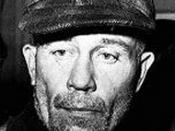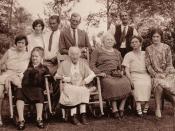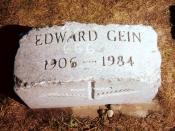Dancing in the Moon Light
When talking about Ed Gein, one of most notorious serial killers in America born on August 27 1906, one could say he had an anything but normal upbringing. He was the son of George P. Gein and Augusta Lehrke, and was the younger brother of Henry G. Gein. With a dead beat, alcoholic father, it is assumed that he did not have a strong father figure in his life, which may have resulted in his strong, almost obsessive connection with his mother. Augusta was quiet bizarre when compared to other mothers of her time. Although she did "bring home the Bacon" by running a small time grocery store that she owned in the town of La Crosse, Wisconsin, home of Ed Gein, she did not stress the same values as other women did in her time. Augusta emphasized to her two sons that all women, excluding her, were evil whores.
She also taught her sons that sex should never be used except to produce offspring. (WIKI. E)
To keep her sons on a tight leash, she taught them to avoid any kind of outside influences. To guarantee her plans, Augusta purchased a farm near the town of Plainfield. Due to his effeminate behavior and a growth over one eye, Ed was often taunted at school by the bullies. After the death of their father in 1941, Henry began to reject Augusta, as he wanted to live a normal life, dreaming about have kids, a beautiful wife, a steady job, and a house of his own. It had gotten to the point where he would criticize his mother while Ed was in earshot. In March of 1944, a brush fire broke out on the farm and the brothers found themselves in the middle of it. The brothers first tried to fight the fire, but then turned tail and ran. Ed ran to get the police and told them that while running away, he had lost sight of his brother, but when asked to take the police to where he last saw his brother, he lead them right to where the body of Henry laid, dead. Although the coroner noticed there was blunt trauma to the groin area and two marks on the back of his head, he quickly dismissed the idea that Ed killed Henry, his own brother, and said that he had died of asphyxiation from the fire. (WIKI. E)
Ed Gein then spent two years alone with only him and his mother in the house before she died from a series of strokes. During this time, it is said that Augusta would sometimes yell at Ed, telling him he was nothing and was a failure at life. But then other times, she would praise him for being such a good son, and would sometimes let him sleep in the same bed as her. (WIKI. E) On December 29, 1945, his mother passed away.
After the death of his mother, Eddie became increasingly forlorn. He began to spend most of his time reading pulp fiction magazines and books on the human anatomy. His collection of readings included periodicals about Nazis, South Sea headhunters, and shipwrecks. From these, he learned the processes of physical mutilation and various forms of bodily disfiguration, which he used as inspirations for his soon to be victims. He became obsessed with these readings and often retold them to the children that he babysat on occasion. He would often read the newspaper to the children as well; his favorite section being the countless obituaries.
It was from reading the obituaries that Gein would learn of the recent deaths of local women which would only arouse his concealed fixation with death and the feminine mystique. He would often visit the graves by night and in secret he would fondle the corpses he had exhumed. He later swore to the police that he had never engaged in any sexual intercourse with any of the dead women, claiming they "smelled too bad." (TRIPOD. D) Gein took an unusual pleasure in peeling off their skin and wearing it over his body as a self procured suit. He was fascinated by women and the power they held over men. He was curious to know what it was like to have a vagina and breasts and he often dreamed of being a woman.
During the late 1940's and 50's, Wisconsin police began to notice an increase in missing persons cases. There were four cases that particularly baffled police. (CRIME.A)
On November 17, 1957, the first of Gein's alleged victims was discovered in his home. Bernice Worden's headless corpse was discovered gutted and hanging by its ankles from the ceiling of Gein's kitchen. After their discovery, the police began a thorough search of the rest of Gein's property, to include the farmland and household. They believed Eddie may have been involved in more murders and that the bodies might be buried on his land, possibly those of Georgia Weckler, Victor Travis and Ray Burgess, Evelyn Hartley and Mary Hogan. In their desperate search for the answers to Gein's assumed crimes, the police uncovered the remains of several more bodies in the house; artifacts to include: a funny-looking bowl made from the top of a human skull, lampshades a wastebasket and an armchair made from human skin, a belt made from nipples, a human head, four noses, female genitalia kept in a shoebox and a heart. The most fascinating and horrific of them all was the suit made entirely of human skin, to include breasts and a vagina.
While the excavations took place at the farmstead, Eddie was being interviewed at Wautoma County Jailhouse by investigators. At first Gein would not admit to the killings of any of the women, however, after more than a day of silence he began to tell everything about the horrible story of how he murdered Elizabeth Worden. When he was questioned as to the nature of where he had procured the remaining body parts discovered in his home, he insisted that he had stolen them from graves and that he had not killed any more people. However, after several more days of interrogation, he finally admitted to the murder of Mary Hogan but claimed not to remember the details of the incident, only that he had accidentally shot her.
Eddie showed no signs of remorse or emotion during the many hours of interrogation. When he talked about the murders and of his grave robbing escapades he spoke very sardonically, even cheerfully at times. He had no concept of the enormity of his crimes. (HORROR.B)
Gein's sanity was in question and it was suggested that during trial he plead not guilty, by reason of insanity. Gein underwent a series of psychological tests, which later concluded that he was indeed emotionally impaired. Psychologists and psychiatrists who interviewed him asserted that he was schizophrenic and a "sexual psychopath." (CRIME.A)
His condition was attributed to the unhealthy relationship he had with his mother and his upbringing. Gein apparently suffered from conflicting feelings about women, his natural sexual attraction to them and the unnatural attitudes that his mother had instilled in him. This love-hate feeling towards women became exaggerated and eventually developed in to a full-blown psychosis.
WORKS CITED
(CRIME.A)
2007 Courtroom Television Network LLC 08 January 2007
<http://www.crimelibrary.com>
(HORROR.B)
Internet Zombie Productions , 1997-PRESENT 08 January 2007
<http://www.houseofhorrors.com/gein.htm>
(FORTUNE.C)
Modus Operandi-Serial killers 08 January 2007
<http://www.fortunecity.com/roswell/streiber/273/gein_cf.htm>
(TRIPOD. D)
N/A 08 january 2007
<http://members.tripod.com/eddiegein/index.htm>
(WIKI. E)
Wikimedia Foundation, Inc. 22:58, 10 January 2007
08 January 2007 <http://en.wikipedia.org/wiki/Ed_Gein>



